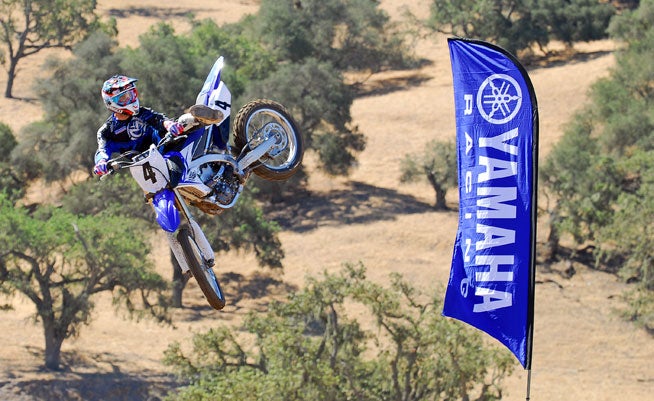
Yamaha set the world on its ear when it debuted its radical, reverse cylinder head YZ450F in 2010. Sure, the ill-fated Cannondale MX400 of 1999 had already introduced the concept to the motocross world, but the difference was that the Cannondale suffered from fuel-injection issues and a lack of power whereas the Yamaha worked well right out of the box. Today, the YZs are the only Japanese motocrossers to use this major mass-centralizing design feature.
Unfortunately, the YZ450F hasn’t been the world beater that Yamaha had anticipated. It has been a solid contender, however, and Yamaha is hoping that the all-new 2014 YZ450F will result in better fortunes for Yamaha on the racetrack. To do that, Yamaha engineers developed it with three essential design goals. Special emphasis was placed on easy cornering, a lighter and more compact package and a more usable powerband.
We were anxious to see how close Yamaha came, and we gladly accepted the company’s gracious invitation to come and try out the YZ450F at the picturesque Zaca Station MX Park north of Santa Barbara, California. Once again, DBC enlisted the services of bullet-fast WORKS and SCORE off-road racer Ryan Abbatoye, still fresh off his runner-up finish with Kendall Norman in the Tecate SCORE Baja 500. Perfect weather and a supremely groomed racetrack awaited the throng of American press who showed up to sample the bike over two full days.
Engine Performance
We already knew that the YZ450F’s liquid-cooled, fuel-injected, 449.7cc, DOHC single is a powerhouse. Its radically over square 97.0 x 60.8mm bore and stroke deliver tractor-like bottom end torque and high-winding top-end horsepower. For 2014, Yamaha engineers were tasked with making the 450F both more powerful and more controllable. Accomplishing the mission required a whole new engine.
Starting from the top, the capacity of air box is increased 265% (from 1216cc to 3230cc), and the filter shape has been changed from flat element to traditional round element with a 35% larger surface area. A new air box layout also eases filter maintenance by allowing access to the filter without requiring removal of the seat or fuel tank.
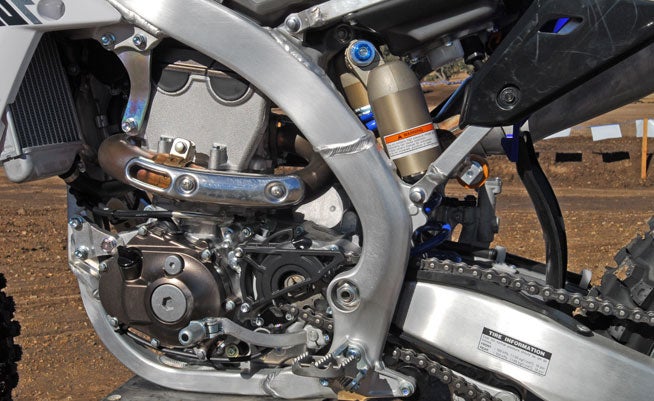
Increasing top end power to foster a more controllable power character may sound counter-productive, but that’s just what Yamaha did. Getting there required new intake cams that feature more duration than the previous cams and larger diameter titanium valves to help the motor breathe better. The new 37mm intake valves are 1mm than in the previous motor, while the exhaust valves gain additional .5mm in size, growing to 30.5mm. The engine also gets new intake and exhaust port shapes to tailor power right where Yamaha’s engineers wanted it.
The 2014 Y450F also gets a new flat-top piston instead of a domed piston, and its combustion chamber volume is increased .9cc to improve combustion for better low-end and midrange torque while still retaining the 12.5:1 compression ratio of the previous engine.
On the track, Abbatoye noted that the YZ450F makes strong power from bottom to top, but its greatest asset is the abundance of locomotive-style torque it generates right off idle. For all its grunt, the engine is smooth and its hit is forceful yet broad. Some of the credit for this feeling lies in the 450F’s new dual-map ECU, which includes a gear position sensor to further optimize the fuel mapping and ignition timing. The new ECU also increases the 450F’s usable rev limit by 250 rpm.
However, throttle response through the 450F’s Yamaha Fuel Injection (YFI) and Keihin 44mm throttle body didn’t feel immediately feel quite right, according to Abbatoye, who noted a tendency for the muffler to sound as if it were shooting ducks when the throttle was closed on the downhill sections of the course. So we spent a little time dialing in the motor even further by experimenting with the fuel injection and ignition mapping. Yamaha’s Jonathan Belding and plugged in the accessory GYTR Power Tuner, dialed up the fuel to 12% rich across the rev range at partial throttle setting and also retarded the ignition by 3 degrees. Presto! The 450F was instantly cured, with crisp and clean fueling and ideal power output for the Zaca Station track. Traction on the wet, tacky Zaca clay was high, but we get the impression that the 450F’s tractor-like power delivery could easily be made to hook up just as well on a dry slick track. We look forward to testing that theory on several So Cal tracks this summer.
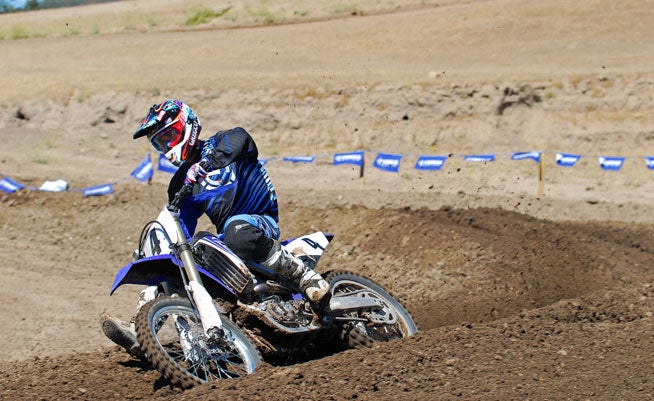
Abbatoye also felt that the YZ450F’s revamped transmission ratios were a little awkward on the long, fast Zaca track—as if third gear needed to be steeper. For 2014, Yamaha has gone to a taller primary ratio (from 2.652 to 2.609) and a lower third gear ratio (from 1.278 to 1.300) to make the gap between second and third gear closer while widening the gap between third and fourth gear. The final gearing has also been steepened from 13/48 to 13/49. The overall goal was to make third gear easier to use in corners and give the motor a stronger pull when shifting through second, third and fourth.
Only Abbatoye didn’t feel that the 450F’s third gear was steep enough, even on the big fast Zaca track, so we swapped from a 49-tooth to a 50-tooth rear sprocket. Abbatoye reported immediate success, as he could stay in third gear on more sections of the course without losing time because the motor wouldn’t pull third gear to his satisfaction.
The YZ450F’s five-speed transmission shifts as smooth as silk and its clutch action is excellent, which is a good thing as Yamaha paid a lot attention to both areas. The 2014’s shift quality comes courtesy of new shift forks along with shift bars that float on springs to reduce binding. The rear shift bar has also been increased from 10mm to 12mm, and the shifting mechanism now features a bearing to reduce friction when going from gear to gear. Other changes include a new shift lever and shift shaft. The 450F’s clutch has also been beefed up via new springs and clutch plate friction material. Spring pressure is increased by 10% to accommodate the motor’s power.
Chassis
It’s hard to say whether the YZ450F’s chassis trumps its motor in terms of improvements, but the 450’s all-new Bilateral Beam chassis is impressive. The new frame moves the front wheel 10mm closer to center of the bike and also features a stronger swingarm pivot. Thicker material in its hydro-formed mainframe spars and a new shape and location of the tension arm that bridges the spars, along with new engine brackets, allowed Yamaha engineers to tailor the chassis rigidity for a more comfortable feel along. More front wheel weight bias is also intended to improve the front-end traction when cornering. Also, the 450F’s front Axle diameter has been increased 2mm (from 20mm to 22mm) to increase front end rigidity.
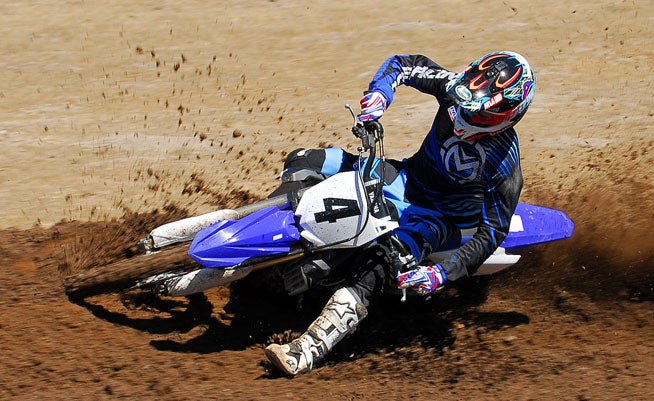
And Yamaha has really taken its mass centralization to a whole new level with the YZ450F. In order to move the bulk of the chassis weight closer to the center of the bike, Yamaha engineers created a new, narrower and smaller subframe, and a new more centrally mounted fuel tank. The most obvious change, however, is the YZ450F’s wraparound exhaust system 3D formed muffler. The mass of the muffler is now lower and 7.3 inches closer to the center of the bike to keep things really compact.
The goal is to create a lightweight feeling machine that changes direction and attitude more willingly, but our experience at Zaca station was mixed. Abbatoye reported that the chassis basically handles well and corners well, but it steer more deliberately and also feels heavier than we expected it to. On the other hand, the bike felt light and neutral in the air, allowing Abbatoye to flick it however he liked.
A slight headshake at high-speeds on one of Zaca’s rougher downhill sections was another handling issue that required attention. Over this section the fork would dive and change the steering geometry just enough to induce headshake. At least this one was a simple fix. Adding two more clicks of compression damping in the fork and backing out the high-speed compression damping in the shock by a quarter turn settled everything down and alleviated the issue completely.
Suspension
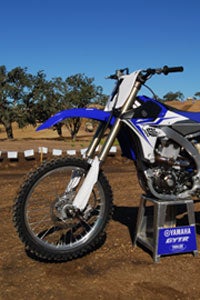
Ergonomics
Yamaha’s mass centralization efforts also yield slimmer ergonomics, more room and better fore and aft movement for the rider. Most noticeably, the fuel filler neck is now mounted under the very front portion of the seat, which is located via two posts and grommets and attached to the main portion of the seat using two nylon tethers. It looks weird not having a visible fuel cap in its normal position on top of the tank, but the design makes it easier than ever for the rider to sit forward and plant the 450F for a tight turn.
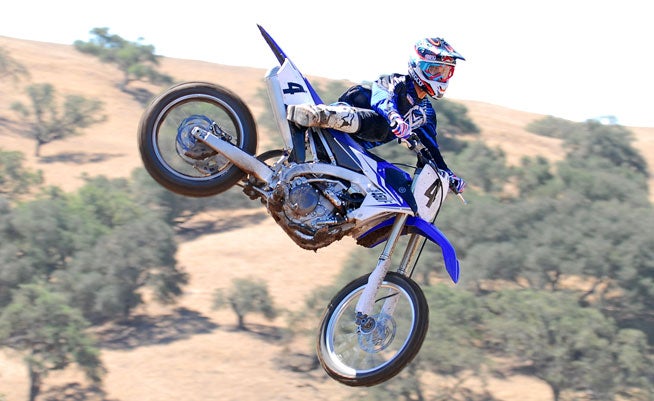
Styling
The 450F was already pretty racy looking before, but its new look borders on space-age. The missing fuel tank cap (it’s hiding under the seat) slim radiator panels and flat seat look futuristic even by today’s standards, although it’s interesting to look back at 25-year-old print mags and see just how close those next-generation renderings really were. The 450F’s graphics are now embedded into its new one-piece radiator shroud, making them impossible to peel off and more difficult to scratch. Of course, the bike also gets all-new plastic, including the radiator shroud, side panels and rear fender. Efforts were made to minimizes the size of the body panels, and give them a more compact, aggressive appearance. However, Abbatoye noted that he didn’t like how wide the front fender gets right under the front number plate, Hey, it’s a subjective thing and he’s fairly qualified to comment; Abbatoye’s business, Ryan Abbatoye Designs, manufactures custom graphics for dirtbikes.
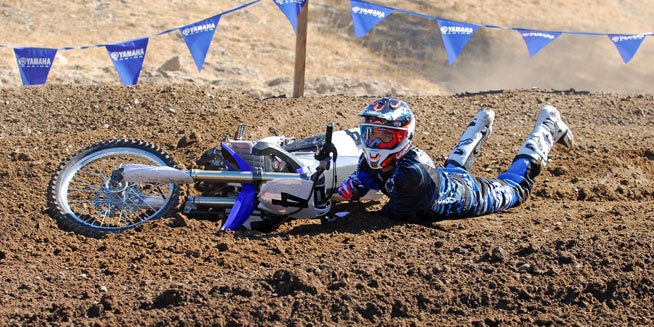
Overall, we’re stoked with the changes Yamaha made to the YZ450F. It offers easy-riding yet thrilling Open-class power, a compact chassis and excellent suspension, making it a serious contender for the class title as well as any local, regional or national motocross championship crown. And maybe the best part of all is that the new YZ450F retails for $8490, same as last year’s model. So if you waited for a year while you’re buddy decided to buy a 2013 YZ450F, or vice versa, one of you is going to be pretty upset.
 Your Privacy Choices
Your Privacy Choices